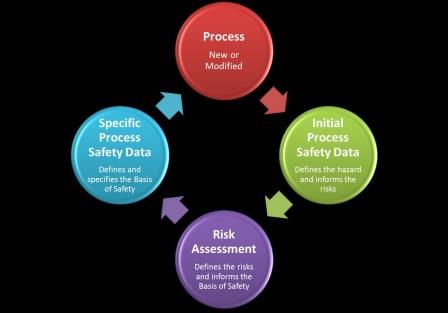Process Safety Data: A Critical Ingredient in Process Safety Excellence
April 1, 2016

Excellence in process safety performance requires an integrated approach to addressing programs, culture, and competency. One important aspect of competency is having a wealth of the right information available, and accessible, to support and underpin the overarching safety management system. This includes both asset information (P&IDs, vessel register, instrumentation, piping and physical equipment inventory, safety systems - including safety instrumented functions, etc. - and process information: batch manufacturing records, quality/IPC procedures, raw material information, material safety data, process safety data, etc.). While the requirements for asset information and most process information is reasonably prescriptive – and hence can be reliably audited and assured - the specification of required process safety data is far from prescriptive. This often leads to ineffective or inefficient systems and can completely undermine otherwise excellent process safety management systems.
1. What is Process Safety Data?
There are various properties of materials that can present process safety hazards. These can be conveniently grouped as properties relating to:
* Dispersed phase deflagration/explosion hazards arising from flammable (explosible/combustible) dust, gas, and vapor clouds
* Detonation or deflagration of highly energetic material (usually condensed phase)
* Fire and burning properties
* Decomposition of thermally unstable materials (substances or mixtures)
* Runaway exothermic and/or gas generating chemical reactions (intended or unintended)
A range of other properties are also relevant to process safety and can lead to multi-casualty scenarios in the event of a loss of containment. Electrostatic properties and phenomena, for example, are often at the root of explosions in providing the ignition source and are highly relevant in the context of process safety data. Other relevant data includes toxicity and ecotoxicity properties and other physical properties that can impact on the consequence of release. These properties, while pivotally important, are not considered “core process safety” properties in the context of this article. The article focuses on the safe handling of powders, and specifically avoidance of dust explosion risks.
Get more information on Instrumentation & Control at the International Powder & Bulk Solids Conference & Exhibition, May 3-5, 2016
Regional regulators have placed stringent requirements on operating companies to conduct risk assessments and implement preventative or mitigating measures to avoid a catastrophic outcome from such events. Regulations and programs, such as the ATEX Directives in Europe and the OSHA Combustible Dust National Emphasis Program in the U.S., have been mandated by the authorities to ensure the risks are adequately addressed, understood, and mitigated. Formal Process Safety Management (PSM) programs also recognize process safety information (PSI) as a cornerstone of excellent performance. Despite these regulations and programs, events continue to occur globally often causing serious injury or fatality (SIF), as well as major property damage on- and off-site.
Avoiding such events might require a single safety system or a combination of measures that collectively protect the plant, personnel, and environment from the consequences of all foreseeable undesirable events. These individual or collective measures – which can be organizational or technical - are defined as the basis of safety for the plant or operation. This basis of safety provides an important anchor point for the evaluation of operational stability by various plant stakeholders. For the plant manager, it provides a concept that he can question and for which appropriate KPIs can be defined (and checked) with an understanding of who has accountability of the various components of the basis of safety. For safety managers, the basis of safety acts as a reference point around which enabling systems can be developed (training needs, tools, and procedures). For engineering and maintenance managers, it provides a basis to proactively introduce and sustain appropriate layers of protection to strengthen the overall robustness of the basis of safety, along with assuring appropriate preventative maintenance programs are in place for the components of the basis of safety. Having a clear, unambiguous, visible, and well-documented basis of safety therefore provides a focus for robust sustenance of plant (and personnel) protection systems.
Any hazard and risk assessment, irrespective of the nature of the hazard or risk, requires a methodical strategy involving:
* Characterization of the process and materials
o Determining the fundamental hazards of the materials and processes involved
* Risk assessment
o Evaluating the risks associated with handling the materials and processes in the proposed equipment under normal and foreseeable abnormal operating conditions
* Consequence analysis
o Determining the consequences of all foreseeable abnormal operating conditions
* Basis of Safety system specification, design, and implementation
o Specification of preventive or protective measures that mitigate hazardous scenarios or reduce the consequences hazardous scenarios to tolerable levels
Deficiency in any of these areas will potentially result in an ineffective – or in the worst case unsafe – basis of safe operation. This generic multi-step procedure invariably iterates between laboratory scientists and plant engineers (touching a range of other disciplines in the process) giving further scope for misalignment. All of this is further compounded by the plethora of process safety data available.
2. Approaches to the Collection of Process Safety Data
Process safety data includes information on the relevant properties of materials in the context of the basis of safety. For any given unit operation – and indeed, any given piece of equipment – the basis of safety can be different for different materials and processes. This potential “ambiguity” poses the biggest challenge to corporations in ensuring robustness in the basis of safety – and the process safety data requirements that underpin it.
In our experience, organizations go about the collation of process safety data in one of several ways, as described below.
Approach 1: Complete Dataset
Some organizations place a blanket requirement to procure a complete set of data on all materials and processes, irrespective of the basis of safety.
Approach 2: Prescribed Dataset
It is not uncommon to find organizations that have a prescribed “list” of data requirements for new or existing materials or processes. The list is often generated from knowledge of typical plant configurations where they are (assumed to be) consistent across a multinational organization. The specific tests are dictated by the requirements of the basis of safety.
Approach 3: Flowchart Approach
In acknowledging that the basis of safety may vary between different handling and processing plants, some organizations use a flow chart to guide material testing towards an ultimate basis of safety. An example of such a flow chart can be found in Figures 1 (for dust/gas/vapor explosion risks). Abbreviations are explained in the glossary at the end of the article.
Approach 4: Tailored (Case-Specific) Approach
Having no prescribed dataset is not uncommon with data requirements for new materials/processes/plant equipment being identified on a case-by-case basis. Where appropriate procedures are followed by competent personnel (i.e. those with relevant subject matter expertise), this can be highly effective and targeted. However, across an organization its robustness becomes a function of local competency and hence it can be prone to inconsistency and resulting variable outcomes.
Approach 5: Prescribed Data + Situational Data Approach
Several key parameters plus selected additional parameters according to processing methods and risks are usually required to define a basis of safety. The key parameters provide initial characterization of the hazards of the materials/processes involved. This data is utilized in a preliminary risk assessment – the outcome of which may be a requirement for further test data for specification of the basis of safety
There are two further approaches that may be taken. The sixth approach is to assume worst case material/process properties and design and implement safety measures accordingly. The seventh approach is ignorance. Thinking that all important process safety properties will be available on a Safety Data Sheet (SDS) has only one ultimate outcome. The less said about this approach the better. Ignorance results from either a lack of awareness (competency issue) or from the culture of an organization in the pursuit of production and profit above all else, and sadly, often to the exclusion of health and safety. While SDSs provide some flammability information for liquids and gases and a trace of reactivity, explosivity, and oxidizing properties information, they are currently bereft of information on dust explosion and thermal stability hazards.
Some assessment of the advantages and disadvantages of each approach to process safety data collation is provided in Table 1.
Of the approaches referenced, the prescribed plus situational approach generally strikes the balance between robustness, effectiveness, and efficiency. The initial prescribed data meets the needs of highlighting the process safety characteristics of the material/process and feeds and informs the risk assessment phase of scale-up. This data must be collected in ALL cases. The subsequent situational data requirements derive from the outcome of the risk assessment which focuses on the additional data requirements necessary to specify the basis of safety. The approach is best described schematically in Figure 2.
To exemplify this approach, the types of data that may be appropriate as prescribed and situational are provided in Table 2 below for flammability hazards.
3. Intelligent Data
Although the immortal declaration of Thomas Jefferson stated that “all men are created equal,” the same is unfortunately not true of process safety data. For any given parameter, there is often a bewildering range of test standards, commercial equipment, and modes of operation that further complicate the challenge of getting the right data from the right test. Sometimes, the differences in test methods between standards are relatively minimal. In other tests, however, the differences can have a serious impact on the data obtained and the decisions that are made based on the data. Some examples of differing protocols for individual properties include:
* Minimum Ignition Energy (MIE) of a dust cloud. Possible causes of variation in data:
o Range of standard methods – IEC 61241-2-3, EN 13821, ASTM E2019, etc.
o Range of commercial equipment – MIKE III (Kuhner), MIE III (Chilworth), etc.
o Optional inductance – two methods exist
* Low inductance method – suitable for electrostatic spark simulation and electrostatic hazard assessment
* High inductance method – suitable for mechanical spark simulation – produces longer duration sparks and hence generally gives much lower MIE values
o Impact of sample preparation – particle size and moisture content of tested material
* Finer particles generally produce lower MIE values
* Drier material generally produces lower MIE values
o Impact of temperature – increase in temperature significantly reduces the MIE of a powder. The impact can span orders of magnitude over modest temperature ranges.
* Thermal Stability of a powder. Wide ranges of:
o Test methods – DSC, DTA (Carius Tube, TSu, RSD, Radex, etc.), diffusion cell, aerated cell, air over layer, adiabatic calorimeters, Thermal Activity Monitors (TAMs)
o Operating conditions – ramped (range of rates), isothermal, stepped o Air availability – important for powder drying scenarios
o Air availability – important for powder drying scenarios
o Sample sizes used in the commercial equipment – from mg to kg – significant impact on sensitivity
o Safety margins required for scale-up – from directly scalable to requiring up to 100°C safety margin for scale-up
These nuances in tests methods, equipment, and test conditions are common to almost all process safety properties. So we arrive at the conclusion that obtaining the correct data for the appropriate property is pivotal in providing the necessary data applicable for the intended purpose. Defining the test method and test conditions requires full consideration of the intended application of the test data. The selection process requires an intimate understanding of the impact of the variables and identifying which combinations of conditions will provide the most applicable data. The quality of test data obtained by an operating company thus becomes strongly linked to the competence of staff that is specifying the test requirements and test conditions.
Testing protocols have to be intelligently specified to provide the correct data for the scenario/purpose. Even once the data is available it remains critical to understand it’s applicability to avoid applying the data to inappropriate situations.
In some circumstances, “standard data” may not adequately characterize the required properties and recognizing this requires knowledge of test method applicability – again, back to competence. Examples of where standard tests may not suffice:
• High pressure and/or temperature operating conditions
• Unique operating conditions
• Simulation of incident scenarios
It is also the case that for some properties, discrete testing programs can offer considerable cost efficiency – without compromising effectiveness. For minimum ignition energy, for example, an organization may have reviewed potential ignition sources and confirmed that all electrostatic ignition sources above a certain threshold have been removed via a combination of procedural and engineering controls. Conducting a full MIE determination may therefore not be necessary; a simple “go/no-go” boundary test may adequately advise the suitability of the material for the specific plant.
Used intelligently, some process safety data can be applied to numerous scenarios, thereby providing cost effectiveness, as well as improved efficiency in data collection. Safety and optimization/rationalization are therefore not necessarily mutually exclusive.
4. Data to Information
Ultimately, the objective of any laboratory testing is to obtain appropriate information necessary for ensuring the safety of our operations to protect our people, assets, and the environment – therein protecting the organization itself. The translation of data to information is therefore as critical as the validity of the data itself. What matters is that we understand what it takes to create a process safety risk (e.g. make a dust cloud explode) and to ensure that we have preventive strategies in place to mitigate the risk or protective strategies in place to mitigate the consequences.
So we compound the complexity of determining the correct parameters to study, with the correct test procedure to derive said data and with a need to adequately and correctly interpret and apply the data to the plant environment. Without a universally prescriptive and accepted procedure, it is clear to see the challenge that process safety data presents to ensuring safe operations – and why so many organizations’ best efforts are compromised in this area.
5. Make or Buy?
Global organizations have taken many different approaches to the decision on whether to equip themselves to provide process safety data internally or to outsource. The advantages and disadvantages of the two approaches are highlighted in Table 3.
For larger global organizations, a balanced approach is often taken whereby some process safety laboratory capability resides in the organization with more exotic or infrequent needs serviced by external vendors. Experience suggests that both options can be successful but the balanced approach tends to strike a compromise between internal competence and capability, and cost. Measuring success in a process safety data program is challenging. Whilst the costs can be readily isolated and analyzed, the quality and impact of programs is a more subjective analysis – unless a large event occurs of course, when it becomes abundantly clear.
6. Summary
Process safety data is a critical component and cornerstone of good process safety management (in its wider and narrower meanings). It is simply impossible to establish safe handling conditions and define a basis of safety without knowing the relevant material and process properties. The only exception is where conservative worst-case properties are assumed – thereby typically overdesigning safety systems, adding considerable expense, and compromising operational efficiency due to maintenance and control demands. It is not uncommon to find process hazard analysis studies conducted without adequate data on which to assess the risk. Decisions that are made, as a consequence, will lack validity and compromise the safety of plant processes. Excellence in process safety data acquisition requires:
• A sound strategy for determining the necessary data requirements, aligned with the basis of safety
• Sufficient awareness of test techniques to specify the correct test combined with sufficient awareness of how to apply the data to specify and underpin the basis of safety
• Acknowledgement that complete process safety data acquisition is often a two-step process
• That the basis of safety is specified for all hazardous material/process handling operations and equipment
• Competence (subject matter expertise) within the organization – on a globally consistent basis – on process safety test specification and data interpretation
• Understanding and managing the multidisciplinary linkages between laboratory operations and plant engineering operations to ensure that data passes seamlessly through the organization, while being consistently understood
Stephen Rowe is a regional director for DEKRA Insight based in Southampton, UK. Rowe was originally a chemist, but has hybridized over the years into a partial chemical engineer through PhD studies with the London University of the South Bank, Chemical Engineering Department. At DEKRA Insight, Rowe co-ordinates and leads DEKRA Insights' EMEA Testing business and its' UK process safety operations.
Glossary
AIT Autoignition Temperature (usually referring to a flammable gas or vapor)
Kg Gas or vapor explosion severity constant
Kst Dust explosion severity constant
LIT Layer (5 mm) ignition temperature (often referred to as smoldering temperature)
LOC Limiting oxygen concentration of an atmosphere required to support combustion propagation (usually referring to dust cloud explosions)
MIE Minimum ignition energy
MOC Minimum oxygen concentration of an atmosphere required to support combustion propagation (usually referring to gas or vapor cloud explosions)
MIT Minimum (dust cloud) ignition temperature
Pmax Maximum pressure of an explosion
Get more information on Instrumentation & Control at the International Powder & Bulk Solids Conference & Exhibition, May 3-5, 2016
For related articles, news, and equipment reviews, visit our Instrumentation & Control Equipment Zone
Click here for a List of Instrumentation & Control Equipment Manufacturers
You May Also Like

